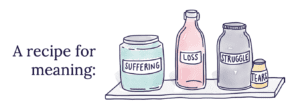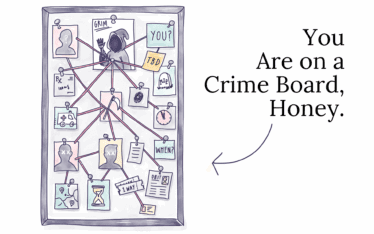Rather counterintuitive in a world that favors comfort, convenience, and sheer and utter pleasure is the idea that humans deteriorate without challenges and adversity placed on our bodies and minds. (Deterioration, to be clear, is not what we’re looking for while we still have Mondays left to live.)
The hedonic pursuit of happiness, characterized by the maximization of positive emotions (love! soaring joy! amusement! lust!) and the minimization of the pesky negative ones (crushing disappointment! fear! shame! blinding rage!) is a well-worn path for most of us: dial the pleasure up, turn the displeasure switch off, right? Nope. Embracing negativity in our lives ultimately leads to positivity. If our goal is to lead flourishing lives, an acceptance — a radical welcoming, even — of the negative side of life helps pave the way.
The Adversity Hypothesis
Furthering his admonishment for the “what doesn’t kill you makes you weaker” ethos in our currently coddled society, Jonathan Haidt introduces the adversity hypothesis: that we reach our peak levels of fulfillment and development because of — not just in spite of — the setbacks, failures and traumas that the cards of life deal us.
He cites three main benefits of adversity that are classified in the realm of post-traumatic growth:
- One is that our self-concept is bolstered when we reveal strengths we didn’t know we possessed… strengths that were previously untapped prior to a tragedy (like being courageous in the midst of turmoil… or being resourceful in otherwise dire straits… or being willing to see multiple perspectives on a contentious issue… or being compassionate towards the person who deeply wronged us). The confidence gained from handling setbacks in potentially surprising ways prevents further stresses from taking their toll.
- A second benefit of adversity is that it strengthens our relationships (after weeding out the friends who didn’t weather the storm by our sides) and makes us more tolerant and thankful for the people who do make the cut/ get to remain in our lives.
- The third post-traumatic growth benefit is that adversity helps orient us to a more present-filled mindset, with clarified priorities. Life goals often change in the aftermath of trauma, when various happiness traps (more money! more choice! more conspicuous consumption!) carry less weight. We tend to care less about the kind of car we drive when we’re just happy to have made it through multiple rounds of chemo and radiation in one piece, for example.
This thing called vertical coherence
Negative events assist in our optimal development through the lens of vertical coherence — the degree that our short, medium- and long-term goals align. When our goals, priorities and motives have been distilled to their very essence, as typically happens through adversity, we have a true shot at happiness when we’re pursuing the things that matter to us on all levels. Trauma provides rich fodder for the stories of our lives, given our propensity to narrate our existence and make meaning of our goals. One of my clients survived a train crash (yes, a train crash, for real) and now lives his life through the lens of his “newfound origin story.” He regularly tells the tale of his life BC (before crash) and AC (after crash), narrating the details of his transformation from a shallow guy (his words, not mine) to a servant leader. His life is beautifully aligned with vertical coherence.
Should we seek out difficulty and struggle to elicit otherwise-elusive meaning to our lives?
Some psychologists say “sure!”… and then wisely clarify that the seeking of suffering isn’t for suffering’s sake (because that would be weird), but rather in service towards a feeling of purpose and meaning.
Paul Bloom aptly points out in The Sweet Spot: The Pleasures of Suffering and the Search for Meaning that “people willingly climb mountains, run marathons, or get punched in the face in gyms and dojos. Others, mostly young men, choose to go to war and, while they don’t wish to be maimed or killed, they are hoping to experience challenge, fear and struggle– – to be baptised by fire, to use the clichéd phrase. Some of us choose to have children, and usually we have some sense of how hard it will be; maybe we even know of all the research showing that, moment by moment, the years with young children can be more stressful than any other time of life, (And those who don’t know this ahead of time will quickly find out.) and yet we rarely regret our choices.”
We get punched in the face (hopefully as boxers and not bar-room brawlers) and we undergo grueling training regimens to run 26.2 miles (in a row!) not because we’re gluttons for punishment, but because we see something bigger out there that will make us feel accomplished/ proud/ fulfilled/ like we did something that matters. Struggle can lead to meaning.

What is appropriate negativity?
Barbara Fredrickson (the highly cited scholar in psychology worth becoming groupie of) nods to appropriate negativity as a key ingredient in lives worth living. She makes a fitting distinction between the negative emotions worth entertaining (anger, conflict and guilt) and the ones worth showing the door (shame, disgust and contempt). In her book Positivity: Groundbreaking Research Reveals How to Embrace the Hidden Strength of Positive Emotions, Overcome Negativity, and Thrive, Fredrickson writes that appropriate negativity grounds us in a gravity-filled reality, in a healthy counterbalance to levity-filled positivity which positions us to flourish. The displays of anger and guilt — in particular in the workplace — have also been shown by some researchers to have un upside; discretely applying these negative emotions during feedback situations lead to better social interactions and creative task performances.
What does positive psychology have to say about negativity?
Let’s refer to one of the founding fathers of this field of study — the late psychologist Chris Peterson, who articulately defended positive psychology’s position on the important role negativity plays in a well-lived life (and it doesn’t involve sticking one’s head in the sands of glorious, sunny, happy beaches [like the hedonic “find your beach” Corona commercials]). Peterson’s veritable laundry list of what ultimately turns frowns upside down is compelling: moments of crisis call upon and refine our character strengths, optimism does its best work in the face of failure, the experience of flow is contingent on overcoming challenge to achieve things that matter, and relationships stand the test of time if partners participate in healthy problem solving. That’s a lot of good wrapped around a lot of bad. Duly noted.
Exposure therapy to the things that suck
Reinforcing the notion that tough times can lead to commensurately better times, the way in which we handle ourselves when we are already down and out is of similar interest. Cognitive Behavioral Therapy is based, in part, on the premise that exposure to the very things that trigger us or cause us to experience negative emotions is instrumental to recovery and ultimately thriving. Experiencing a stressful stimulus in measured doses — like imagining a performance conversation with a contentious manager, then making the appointment to have the conversation, then practicing the words in front of a picture of the dreaded boss, then actually having the conversation — re-activates this subordinate’s anxiety (damn it), yet leads to habituation, recovery, and greater well-being (worth it).
The internal locus of control
Having an internal locus of control — the belief that we have the power to control events and outcomes through our own behavior — has been shown to ameliorate the effects of adversity. Jonathan Haidt uses a clever metaphor to illustrate how challenging it can be to acquire a robust internal locus of control; he likens our limbic system — known for its often uncouth basic instincts — to a wild elephant, and our gray matter-filled neocortex — whose claim to fame is for rational thought processing — to the rider of the unruly beast. Adversity offers us the seemingly unfortunate chance to tune into the elephant’s true desires, causing the rider to pause and potentially re-design and realign goals that allow for enhanced well-being.
It appears that the well-lived life is reached in part because of the poignant contrast that exists between the highs and the lows — the troubles, setbacks and even traumas that life presents. We don’t need to experience the depths of hell-being to earn our stripes towards well-being, but adopting the perspective that negativity is required for a full, rich life of meaning, can motivate us to tame the elephant in a way that lets us tune into the upside of the dark side.







